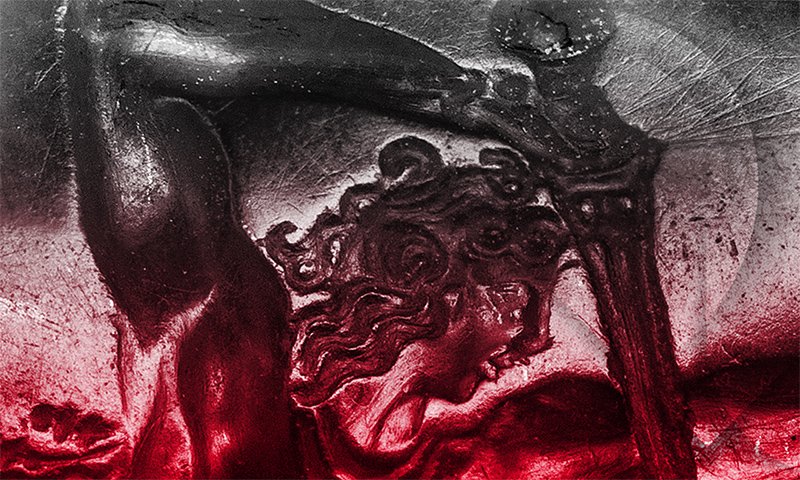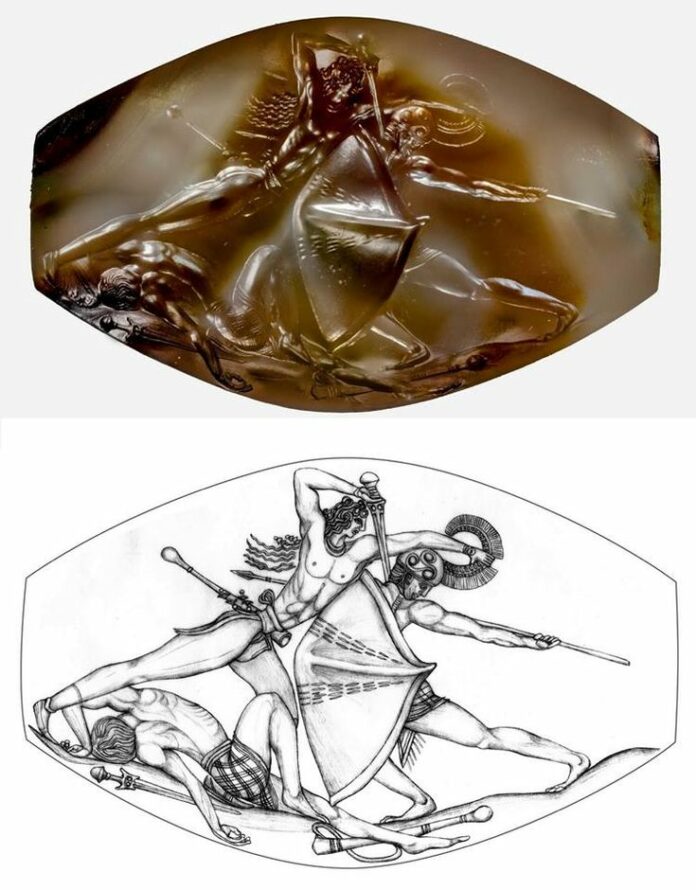The discovery of the “Pylos Combat Agate,” a tiny gemstone etched with intricate detail, has captivated historians and art enthusiasts alike. This remarkable artifact, unearthed from the tomb of a Bronze Age warrior in southwest Greece, offers a glimpse into the artistic prowess of ancient Greek civilization. Let us delve into the story of this incredible find and its historical significance.
A Stunning Discovery

Unveiling the Masterpiece
The “Pylos Combat Agate” was initially discovered two years ago among 1,400 artifacts in the 3,500-year-old tomb of the Griffin Warrior. At first, researchers regarded it as a small bead of little significance. However, after meticulously cleaning away thousands of years of limestone and grime, they unveiled a scene of stunning detail etched onto the gemstone, depicting a victorious warrior in the heat of combat.
The Griffin Warrior’s Tomb
The tomb itself, discovered in 2015, was a remarkable find. It housed the well-preserved skeleton of the Griffin Warrior, named for the plaque depicting a griffin—a mythical creature with the head and wings of an eagle and the body of a lion—found among the burial items. The warrior was buried with a collection of gold signet rings, a bronze sword, and other riches, indicating his high status. The gemstone, initially overlooked, emerged as one of the most significant artifacts from the tomb after a routine cleaning.
The Intricate Carving

The Cleaning Process
Researchers from the University of Cincinnati spent nearly a year cleaning the “Pylos Combat Agate” before revealing its intricate details. The gemstone’s carving, barely visible to the naked eye, requires photomicroscopy to be fully appreciated. Some details are as small as half a millimeter, prompting speculation about the tools used to create such fine work. Despite the absence of magnifying tools from that period, the precision of the carving is astounding.
A Scene of Combat
The scene depicted on the gemstone is one of violent combat. It shows a victorious warrior, having conquered his first opponent, raising his sword to strike another enemy. The level of detail is extraordinary, with individual muscles clearly visible on the human figures. This scene, reminiscent of the grandiosity found in Greek epics like “The Iliad” and “The Odyssey,” showcases the artistic skill of the time.
Historical Context

The Complexity of the Carving
The complexity of the carving on the “Pylos Combat Agate” has forced historians to reconsider the artistic capabilities of the Aegean Bronze Age. No other carvings from this period have been found with comparable detail. According to University of Cincinnati professor Jack Davis, such detailed works of art would not be seen again for another thousand years. This level of artistry challenges previous assumptions about the sophistication of art in ancient Greece.
Influences and Cultural Exchange
The Griffin Warrior was buried around 1450 B.C., during a politically tumultuous period in ancient Greece. It is widely believed that the Greek mainlanders, the Mycenaeans, conquered the Minoans on the island of Crete. Minoan art greatly influenced the Greek mainland, and many Minoan artifacts from this period may have been imported or looted. The Griffin Warrior’s tomb, with its mixture of Mycenaean and Minoan artifacts, suggests a high level of cultural exchange and influence.
The Mystery of the Depiction
Artistic Interpretation
The exact story depicted on the “Pylos Combat Agate” remains a mystery. Researchers have not found enough clues to link the scene to specific oral traditions that later inspired Homer’s epics. However, they believe it likely depicts a legend that was well-known at the time. The tomb’s location on the Peloponnese peninsula at Pylos, near the site of King Nestor’s palace as described in Homer’s “The Odyssey,” adds to the artifact’s intrigue.
A Sketch of the Gemstone

An illustration of the “Pylos Combat Agate” reveals the incredible detail of the carving. The victorious warrior, muscles tensed and sword raised, embodies the grandiosity and heroism typical of ancient Greek epics. This small gemstone, no larger than an inch and a half, captures a moment of intense drama and skillful artistry.
Conclusion
The discovery of the “Pylos Combat Agate” offers a rare and valuable insight into the artistic achievements of ancient Greece. This tiny gemstone, with its intricate and detailed carving, challenges our understanding of the artistic capabilities of the Aegean Bronze Age. The Griffin Warrior’s tomb, with its rich array of artifacts, highlights the cultural exchange and influence between the Mycenaeans and Minoans. As researchers continue to study this remarkable find, the “Pylos Combat Agate” stands as a testament to the enduring legacy of ancient Greek art.
